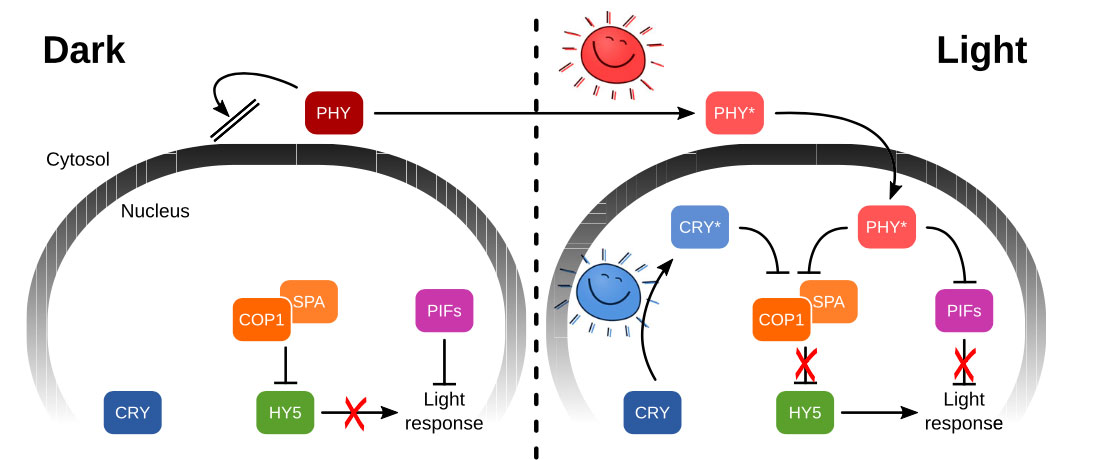博文
New Phytologist:植物中光信号转导的演化
|||
Shedding light on the evolution of light signalling
First author: Andreas Hiltbrunner; Affiliations: University of Freiburg (弗莱堡大学): Freiburg, Germany
Corresponding author: Andreas Hiltbrunner
Phytochromes and cryptochromes are light receptors in plants that are important for the regulation of growth and development (Paik & Huq, 2019). Light in the red and far‐red light range of the spectrum is perceived by phytochromes, while cryptochromes are sensitive to blue light. In seed plants, the CONSTITUTIVELY PHOTOMORPHOGENIC 1/SUPPRESSOR OF PHYA‐105 (COP1/SPA) E3 ubiquitin ligase complex suppresses light responses in the dark by targeting ELONGATED HYPOCOTYL 5 (HY5) and other positive regulators of light signalling for proteasomal degradation(Fig. 1, dark) (Hoecker, 2017). Light‐activated phytochromes and cryptochromes inactivate COP1/SPA and thereby allow these positive regulators to accumulate and trigger photomorphogenesis (Fig. 1, light). Phytochromes and cryptochromes have been studied in different green organisms, including mosses, ferns, and seed plants, but research on signalling networks acting downstream of the photoreceptors has focused almost exclusively on seed plants. In the recent New Phytologist article, Artz et al. (2019) show that the two SPA genes in Physcomitrella patens, SPAa and SPAb, play a role in light signalling but that there are striking differences compared to the function of SPAs in Arabidopsis.

Fig. 1 Simplified model for COP1/SPA‐ and PIF‐mediated regulation of light responses. In dark‐grown Arabidopsis seedlings, light responses are repressed by the COP1/SPA E3 ubiquitin ligase complex, which targets positive regulators of light signalling (e.g. HY5) for degradation by the proteasome. In parallel, members of the PIF subgroup of bHLH transcription factors inhibit light responses and promote etiolated growth in the dark. Phytochromes (PHY, inactive state; PHY*, active state) are red/far‐red light receptors that accumulate in the nucleus when activated by light. Light‐activated phytochromes suppress COP1/SPA activity and thereby allow positive regulators of light signalling to accumulate. Cryptochromes (CRY, inactive state; CRY*, active state) are sensitive to blue light and in the active state also inhibit COP1/SPA. In addition, the active form of phytochromes inhibits PIF activity both by promoting their phosphorylation and degradation and by other mechanisms. The components shown in the model are also present in Physcomitrella but regulatory mechanisms are partially different in Arabidopsis and Physcomitrella. Arrows, positive regulation; blunt arrows, negative regulation.
植物色素和隐色素是植物中的光受体,对生长和发育的调节至关重要(Paik&Huq,2019)。植物色素能够感知光谱中红光和远红光,而隐色素则对蓝光比较敏感。在种子植物中,黑暗条件下COP1/SPA E3泛素连接酶复合物通过靶向HY5和其它光信号转导的正向调控子促进蛋白酶体降解,从而抑制光响应(图1左;Hoecker,2017)。光活化的植物色素和隐色素会使COP1/SPA失活,从而使这些正调节因子积累并诱发光形态发生(图1右)。目前,许多生物中的植物色素和隐色素已经被研究得很透彻,包括苔藓、蕨类和种子植物,但是对于光受体下游的信号转导网络基本只有在种子植物中才有所研究。最新一篇新发在New Phytologist上的文章,Artz等人研究了两个小立碗藓SPA基因的功能,发现其在光响应中发挥重要作用,但是和拟南芥中的SPA基因功能又存在显著的差异。
P.S. 该文是对于德国科隆大学Artz et al.于2019年6月21日发表在New Phytologist上一篇文章的评论,链接:https://doi.org/10.1111/nph.16004
通讯:Andreas Hiltbrunner (https://www.bioss.uni-freiburg.de/prof-andreas-hiltbrunner/)
个人简介:1999年,瑞士苏黎世联邦理工学院,学士;2003年,瑞士苏黎世联邦理工学院,博士;2003-2009年,德国弗莱堡大学,博士后。
研究方向:植物中的光感知和信号转导。
doi: https://doi.org/10.1111/nph.16175
Journal: New Phytologist
Published date: October 06, 2019

https://blog.sciencenet.cn/blog-3158122-1201110.html
上一篇:Current Biology:玉米和高粱花序发育的“反沙漏模型”
下一篇:Nature:2011年背靠背发表的植物感知氧气浓度分子机制
全部作者的其他最新博文
- • Plant Physiology:CsMADS3促进柑果中的叶绿素降解和类胡萝卜素合成(华中农业大学)
- • Molecular Plant:LBD11-ROS反馈调节作用于拟南芥的维管形成层增殖和次生生长(浦项科技大学)
- • Science Advances:根结线虫通过调控植物的CLE3-CLV1模块,促进侵染进程(日本熊本大学)
- • Nature Communications:油菜素内酯参与植物营养生长期转变的分子机制解析(浙江农林大学)
- • Current Biology:光合作用产生的蔗糖驱动侧根“生物钟”(德国弗莱堡大学)
- • PNAS:花同源异型基因在叶中被抑制、花中被激活的分子机制(南卡罗来纳大学)